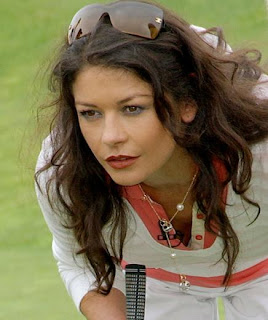Sunday, October 31, 2010
Being in an ensemble cast is the best. You're all in the same boat. You're all together" - on being part of "The Division" (2001) cast.
I have a lady, she's a great lady. I love her a lot, she loves me. We're on the same page. Whenever that day happens when we're not on the same page we'll move forward with it. We're interested in having our lives be our lives right now and not a third person's vis-à-vis marriage and whatever that means. - on his relationship with long-time girlfriend Jennifer Westfeldt.
[On his advice to aspiring actors] I guess I would say, "Don't be afraid to fail." It's not the end of the world, and in many ways, it's the first step toward learning something and getting better at it. If you live your entire life never having failed at anything, it's got to be a weirdly false existence in so many ways. So I think that-depending upon the age, obviously-that would be my bit of advice. Just don't be afraid to fail.
[On teaching acting] I went back to my old high school after I graduated college. I didn't have any money. Literally, no money. So I had to find a job, and I started waiting tables a little bit, and I had the idea that I would go back and talk to my old high-school acting teacher. I said, "Hey, man, what do you think of this idea? Would it be helpful if I came back, and taught all the classes you don't want to teach, or that you're too busy to teach? And helped you out? I'm cheap." And he said, "That's a great idea. I'd love the help." And so we together pitched it to the headmaster, and he was like, "Sounds great. It's too late to start this year, why don't you start next year?" So I took a year, I waited tables, and then I taught school for a year, and after that I was 25, I think, and I was ready to try to go. I had a little bit of money saved, and my car sort of ran, so I was like, "You know what, I'm gonna try it before I get any older and I lose any momentum I have." And west I came.
I went to a high school where you were encouraged to do a lot of different things, so there wasn't this great divide between the jocks and the theater guys, or the smart kids and the stoners, or whatever. It was like everybody was a little bit of everything, and that was encouraged. I was a pretty serious athlete for a long time, and thought maybe that's what I wanted to do with my life, but I was also a diligent student, and really wanted to achieve in that area, too. And theater was kind of a challenge, like, "Oh, maybe I could do that, that looks like fun." So I started doing it a little bit in 11th and 12th grade, and got pretty good feedback, and kept getting cast to do bigger and bigger parts. And I started to think, "Oh, maybe this is something I could do." But I went to college and kind of forgot about it until I was a junior, and I randomly answered an ad in the paper for some production of Midsummer Night's Dream that was coming through. They were casting students as the young lovers, and having an open audition. I remember looking at my roommate and going, "You know what, fuck it, I'm gonna audition for this thing. What's the worst that could happen?" And I did, and I got it. And then the theater department was like, "You should be in the theater department, why are you not? You're good at this." Enough people kept saying, "You know what? You're kind of good at this. Why aren't you doing it for real?" that finally I started listening, and over the next couple of years at school, I ended up getting a theater scholarship, and doing close to 15 plays over two years, and really focusing on it. But at every level, you're constantly reminded that there are other people that do it better than you and have been doing it longer than you. It was a real wakeup call coming to L.A., where it's, "Well, you're not the go-to guy that you were in the University Of Missouri theater department. Now there's 100,000 people ahead of you in line." But for whatever reason, it didn't faze me. I just kept plugging away, and putting one foot in front of the other, and showing up.
(On landing his role in Mad Men) It was amazing. I read the script, and it was for AMC, and I thought, "They've never done anything that's remotely like a TV show, so what's that going to be like?" I read the script for Mad Men and I loved it. Then I realized that a guy who wrote for The Sopranos, Matt Weiner, created it, so I thought, "Okay, that's pretty cool." But I never thought they'd cast me-I mean, I thought they'd go with one of the five guys who look like me but are movie stars. Obviously, they didn't. I literally had to go through six or seven auditions. They flew me to New York to meet all the people at AMC. My final audition was at that bar on the roof of the Hotel Gansevoort. When we were riding down on the elevator, the woman in charge of whatever the decision-making process was told me, "You got the job."
(2010) I certainly go after what I want. But I just have detached amusement about a lot of it. Because it's silly. This job is ridiculous. There's a line from 30 Rock that Tracy Morgan says that makes me laugh out loud: 'I remember that movie-I got paid one million teacher salaries.' It is what it is.
A portrait of Pothia, Kalymnos
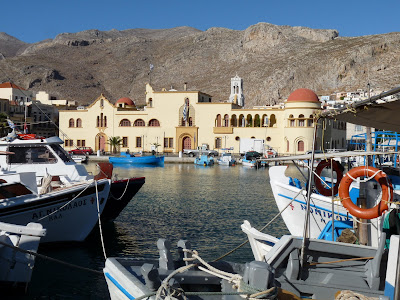
Kalymnos draws you in and so do the Kalymnians with their heightened sense of solidarity forged in adversity from earning a hazardous living from the sea and land and from asserting their culture, religion and Greek nationality in the face of 700 years of occupation by Crusader Knights of St. John, The Ottoman Turks, Fascist Italy, Nazi Germany and more benignly the British before Kalymnos was finally unified with Greece in 1948.


The Convent of All Saints overlooking Pothia. It is dedicated to and contains the remains of the Patron Saint of Kalymnos, Agios Savvas
The harbour of Kalymnos is confusingly called both Kalymnos and Pothia (“The Port”). Originally the capital of the island was 4 miles further inland at Chora (“The Town”) which huddled up close to the fortress of the Knights of St. John, Pera Kastro. This was not by choice. Before the island was ceded to the Ottomans and the forces of Suleiman the Magnificent in January 1523 after the Fall of Rhodes the whole of the Mediterranean was terrified by pirate raids both by Christian and Muslim Corsairs. It was only with the relative peace of the Ottoman years who in the tradition of the Empire in return for loyalty showed tolerance to the Orthodox faith and left Kalymnos largely to its own devices that people gravitated from Chora down to the sea and built houses in Pothia, the port area. What grew up was largely unplanned so today we see a typical port layout of narrow alley ways heading up the valley which Pothia is built in from the port with many handsome stone built houses of the merchants, captains and artisans involved in sponge fishing and sea trade as the port and trade grew.
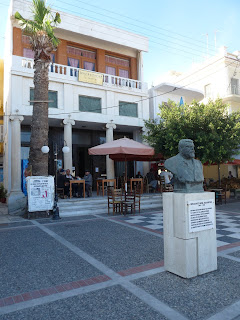

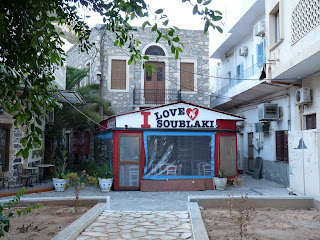
The “main street” of the island is the harbour front of Pothia (The Port) which has a dramatic setting in a natural amphitheatre facing towards Kos, some 10 miles distant. The life of the island revolves around this harbour front with fishing boats; inter island ferries and visiting yachts and pleasure boats providing a continually changing spectacle. The harbour front is best viewed from the sea where the domes of the Orthodox churches on and overlooking the harbour, the Italianate public buildings from the Italian Occupation (1912 – 1944) and the whitewashed houses rising from the harbour front provide a charming vista leading the eye onwards as far as the Kastro, the 14th Century Castle of the knights of St. John who occupied these islands from 1308 to 1522 when the forces of Suleiman the Magnificent conquered them.
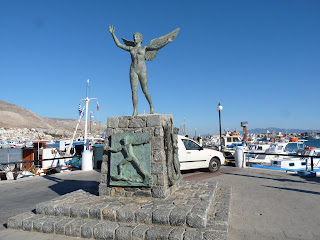
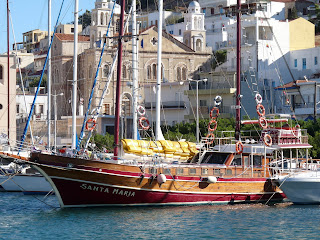

Pothia itself is a bit like a Monet, looks better from a distance but not so good close up. It has a bustling harbour front but the traffic is heavy with the buzzing of young exhibitionistic Kalymnians on scooters penetrating everywhere. If you see somebody with a helmet they are likely to be a tourist, indeed if they are a tourist they are also likely to be insured as well! It is difficult to know what the police do here other than stay in their station and keep cool! Pothia is bustling but with little evidence of proper planning or indeed traffic management.
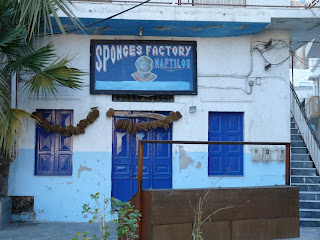
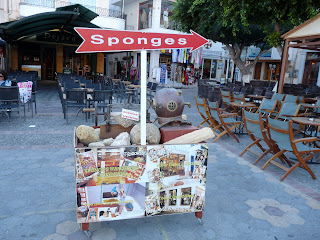
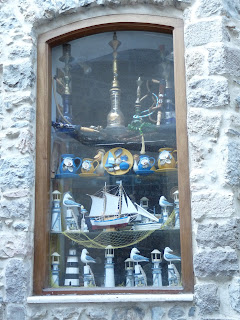
In the 19th Century this was the centre of the world sponge industry and still an important festival takes place one week after Easter just before the sponge fleet departs for its four-month expedition to the waters between southern Italy and the north coast of Africa. Known as Sponge Week, the weeklong celebration is feast of food, drink, and dance. The dances depict the relation between the Kalymnian people and the sponge (the Kalymnian “Gold” as it is often referred to) and recount the joy and the tragedy of this incredibly dangerous deep-sea endeavour. Known as the “Dinner of Love” in former times it was a poignant affair as roundly 20% of the divers would either be killed and not return or be crippled by the “bends”.




For the sponges which made Kalymnos famous and wealthy were both a blessing and a curse. Originally the sponge divers dived naked with a rope and a weight and a net to collect the sponges. As they used natural lung power they could only stay down for a few minutes each time. When the diving suit with an airline came in towards the end of the 19th Century the productivity and the harvest increased but there was no understanding of the bends and no decompression facilities on the ships when things went wrong. So a terrible toll was taken each year with some years perhaps one in five of the sailors who took to sea each April either not returning or coming home crippled. When the fleet departed the Kalymnian women donned their black “widows weeds” until they saw their husbands again. Often having lost a husband a widow would have to send their child to sea with the fleet the next year for otherwise the family would starve the next winter.

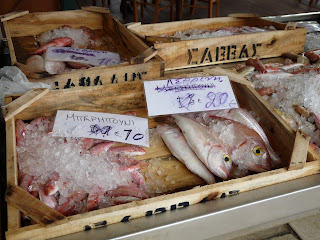

This is a story ably told by an English woman settled on the island, Faith Warn in her book “The Bitter Sea”. It tells of the wealth and lavish lifestyle brought by the golden harvest to a few traders and dealers. The incredibly hazardous diving methods used to gather the sponges - and their terrible toll on the Kalymnos men folk and the sudden catastrophe of the virus destroying the Mediterranean sponge beds and the founding of new Kalymnian communities in America and Australia. In Greece, Kalymnos was known as “The Island of Widows.” Today tourists and day trippers from Kos are brought to “sponge factories” but in truth there are few Mediterranean sponges in Kalymnos.




Today this is a very “Greek” Greek island with its own distinctive cultural and musical traditions and little trace that for 640 years until 1948 it was separated from Greece proper. The reasons it maintained its Greek identity are to be found in its language and religion. Overlooking the harbour at Pothia on a hill is the Covent dedicated to St. Savvas, Agios Savvas, the Orthodox priest who led the opposition to Italian rule and the latinisation of the island and who died in 1948, the year Kalymnos was reunited with the motherland.


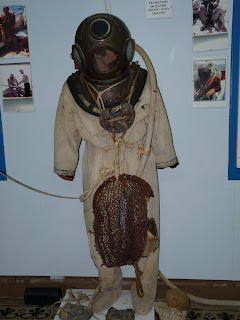

Arriving, as most visitors do, by sea in Pothia your eye is drawn to the handsome Venetian style harbour front buildings framing the Orthodox Cathedral. Beyond in the distance you can make out on a height the ramparts of Pera Kastro, the fortified town of the Knights of St. John. On the left of the harbour you will see the silver dome of the cathedral size Church of Agios Nikolas, built by the sponge merchants who fell out with the Orthodox Bishop in the 19th Century and towering over the harbour on a crag to your left is Convent of All Saints, dedicated to the Patron Saint of Kalymnos whose body can be viewed there.

St. Savvas the New, Icon and picture
St. Savvas the New is the patron of Kalymnos, where he lived during the last twenty years of his life as the priest and spiritual father of the nuns of the Convent of All Saints. He is regarded by Kalymnians as a great ascetic, confessor, iconographer and miracle-worker. He is one of the recently recognized saints in the Orthodox Church. Illuminated at night the Covent provides a beacon over the island whilst down below in Pothia the rows and rows of café’s lining the harbour front provide an open air drawing room for the island, albeit a noisy one due to the moped madness which infects the island.


Pothia’s various Municipal buildings were constructed by the Italians between 1930-35 in a Venetian style on either side of the Orthodox Cathedral and Bell tower and they adorn the seafront along with a variety of shops and cafes. Pothia is built in a natural amphitheatre and the eye is drawn inwards as you approach the harbour to the satisfying composition of the buildings with their domed corner turrets, arcaded colonnades and balconies and the bell tower providing the visual exclamation mark.
Up close there are stucco cartouches with a lyre representing the unique musical tradition of this island and ceramic arms of the House of Savoy. The building on the right of the Cathedral has on the first floor the Mayoralty but the ground floor was a covered market with a central courtyard shaded by palms. Kalymnos is a badly administered island and 10 years or more ago they decided to “modernise” the market. Well many years later it is still being modernised but in the process they have subdivided the building destroying its architectural integrity. As well as being architecturally inept the harbour front really needs a venue such as the Merkato on Kos where the many day-trippers and visitors to Kalymnos could savour and purchase the produce of the island so the current mess is a big loss to the island.
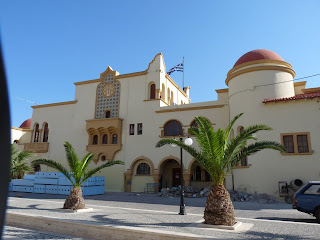

The harbour front bustles all year round for even in winter the returnees from the Kalymnian Diaspora to Tarpon Springs in Florida and Darwin in Australia return so the cafes and restaurants bustle all year round and English is widely spoken, albeit with an American or strine accent!



Sitting in a café on the harbour front of Pothia at night surrounded by the hustle and bustle of this busy town with its illuminated churches and watching the ballet like motions of the implausibly large inter island ferries which enter and exit the harbour in less than 15 minutes you absorb something of the pride and spirit of this ancient crossroads which is uniquely Greek. Not for nothing does the English language have a word “idyllic” meaning to wander happily amongst the islands. Despite everything, Kalymnos and its wayward, noisy, crowded, maddening but endearing capital Pothia has drawn you in.

Pothia from the Convent of All Saints
Labels:
Agios Savvas. Kalymnos,
Bitter sea,
Chora,
Dinner of Love,
Dodecanese,
Greece,
Greek Islands,
Honey,
Kalymnos,
KALYMNOS MUSEUM OF ARCHAEOLOGY,
Kastro,
Knights of St John,
Ottomans,
Pothia,
Sponges
Saturday, October 30, 2010
Catherine Zeta-Jones
Catherine Zeta-Jones - Catherine Zeta-Jones is carrying on with plans she and Michael Douglas made before he was diagnosed with throat cancer in August. "There's nothing better than just having nothing else to focus on than a still white ball, and nobody's looking," Catherine Zeta-Jones was quoted saying at the the Mission Hills Star Trophy golf tournament in Haikou, China..
Catherine Zeta-Jones, CBE, is a Welsh actress, currently based in the United States. She began her career on stage at an early age. After starring in a number of UK and US television...
Catherine Zeta-Jones, CBE, is a Welsh actress, currently based in the United States. She began her career on stage at an early age. After starring in a number of UK and US television...
UTTARA UNIVERSITY
Uttara university
Uttara University (Bengali: উত্তরা বিশ্ববিদ্যালয়) or (UU) is a private university located at Uttara, in Dhaka, Bangladesh.
 Vision: We look forward to having a transformational impact on our society with international quality service rendered by our students imbued with the spirit of humanity, professionalism and holistic academic excellence.
Vision: We look forward to having a transformational impact on our society with international quality service rendered by our students imbued with the spirit of humanity, professionalism and holistic academic excellence.
Mission
Students from families of all levels of income groups should have the opportunity to invest for the development of their individual potential, acquire education and training, and fully utilize their ability in all spheres of life and express themselves freely and creatively. Human development, economic growth and freedom are correlated. The task before us in the populous country of Bangladesh is to develop human resources by investing in people and facilitating their initiative. The university mission is to develop skilled and competent graduates and shape them to fulfil the national need for those persons in business, education, information technology, and related fields as well as to meet the growing demand for productive services required for socio-economic development of the country.
Uttara University
Uttara University is organized into five schools and eleven departments. The university currently offers twenty five programs in undergraduate and postgraduate level.
Uttara University (Bengali: উত্তরা বিশ্ববিদ্যালয়) or (UU) is a private university located at Uttara, in Dhaka, Bangladesh.
Mission
Students from families of all levels of income groups should have the opportunity to invest for the development of their individual potential, acquire education and training, and fully utilize their ability in all spheres of life and express themselves freely and creatively. Human development, economic growth and freedom are correlated. The task before us in the populous country of Bangladesh is to develop human resources by investing in people and facilitating their initiative. The university mission is to develop skilled and competent graduates and shape them to fulfil the national need for those persons in business, education, information technology, and related fields as well as to meet the growing demand for productive services required for socio-economic development of the country.
Uttara University
Uttara University is organized into five schools and eleven departments. The university currently offers twenty five programs in undergraduate and postgraduate level.
1. UTTARAUNIVERSITY There are many private universities in Bangladesh.Uttara university is one of them.It was established in 2003.It is located sector 6 at uttara in Dhaka.Al most 5000 student are studing in this university.It has many kinds of courses like BBA,EMBA, ,MBA,LLB,LLM ,ENGLISH,BANGLA, ISLAMIC Studies,B.ED, M.ED, B.P.ED, M.P.ED B.SC, M.SC, EEE, PHYASIC,COMPUTER SCIENCE and others.There is a digital lab in this university but the computer facilities are aviable.
2. SCHOOL :FOUR
3. DEPARMENT :ELEVEN
4. PROGRAM: 29
5. SEMESTER:THREE IN A YEAR
6. CUMPAS :TWO
7. LIBRARY: THREE
8. COMPUTER LAB:THREE
9. DIGITAL LAB:FIVE
SCHOOL OF BUSIENESS ADMINSTRATION, SCHOOL OF SCIENCE & ENG., SCHOOL OF ARTS& SCIENCE, SCHOOL OF PHYASICAL EDUCATION
UNIVERSITY HOLYDAY: SUNDAY
few picture in uttara university
study tore pic
Known thes about above click below
www.uttarauniversity.edu.bd
few picture in uttara university
study tore pic
Known thes about above click below
www.uttarauniversity.edu.bd
Kristen Stewart says she doesn’t see herself as a celebrity and is annoyed by the attention her personal life receives.
The actor who made her name playing Bella Swain in the Twilight movie franchise says:
“Nothing about being a celebrity is desirable,” she said. “I’m an actor. It’s bizarre to me that everybody’s so obsessive.
Kristen Stewart looked truly sophisticated at the Cinema Society's screening of her new film "Welcome to the Rileys" thanks to her one-shoulder Valentino lace looker and Brian Atwood pumps
Subscribe to:
Posts (Atom)
 Jon Hamm More at IMDbPro »
Jon Hamm More at IMDbPro »
